Engineering firm Arup (famous for the Sydney Opera House and many more global landmarks) has been pushing the boundaries of alternative production techniques for the building sector, with a focus on generative design and 3D printing metal. Generative design is a computational design approach that generates lightweight but highly complex structures. Arup’s publication about a 3D-printed steel structural node generated much interest. The node forms part of a wider structure with 1600 nodes of 1200 individually different shapes.
Despite the potential of 3D metal printing for Arup, the implementation encountered difficulties in the building sector. Printer build chambers are small, production speed is slow for 1600 pieces, costs are high, and perhaps the biggest hurdle is regulation: construction safety standards do not allow for 3D metal printed parts in critical positions as yet.
Hybrid technology
3Dealise (the industrial 3D printing and 3D engineering company) worked with Arup to trial a hybrid production method for generative designs, using both 3D printing and traditional technology. 3Dealise used an industrial 3D sand printer to print a sand mould, and then worked with a foundry to produce a casting. This approach combines benefits of 3D printing such as design freedom, short lead time and digital accuracy, with benefits of traditional technology, such as capacity to produce large products and pre-approval by regulations.
Due to the complexity of the generative design of the node, conventional approaches to sand mould design would not work. Therefore, 3Dealise invented an entirely new approach to mould design. As a consequence, process changes across the production stages had to be developed and implemented as well.
Results
A copy of a node that 3Dealise produced for Arup will be on show at the TCT Show in Birmingham from 26 to 28 September 2017.
Together, Arup and 3Dealise demonstrated the following:
• Hybrid 3D printing is technically and economically feasible for generative designs
• Weight reduction of 75% achieved by the generative design compared to traditional designs
• Lead time of several weeks for 1600 nodes, which is much faster than 3D metal printing
• Production cost 90% cheaper than 3D metal printing
• Regulatory approval is straightforward for this process
• More sustainable production method due to material savings in the entire construction
Salomé Galjaard of Arup commented: “An interesting shift is taking place; whereas the focus initially has been on printing final products, 3D-printing is being applied in an earlier phase in the production process. The aim is to make the most of the freedom-of-form opportunities of 3D-printing without the limitations which are now still considered with production.”
3Dealise CEO Roland Stapper added: “This project highlights two key points: First, this hybrid 3D printing approach is feasible both technically and economically for production of generative designs in the building industry. And there are no regulatory hurdles, so there is really nothing stopping the application on a large scale in the sector.
Second, this technology has a huge cost advantage over direct 3D metal printing, particularly for larger products. 3D printing is often associated with relatively small products, but the benefits of 3D printing are also cost-effectively available for a whole class of larger and heavier metal products in critical loadbearing positions.”
Source: 3Dealise
×


